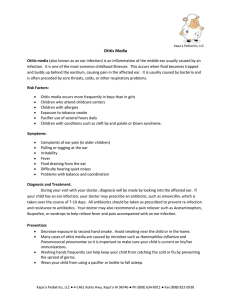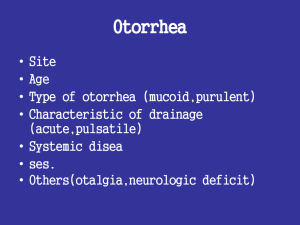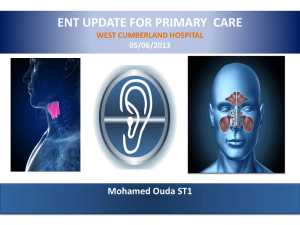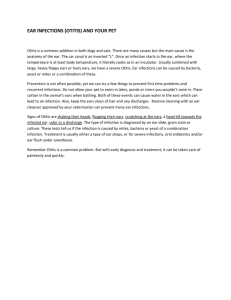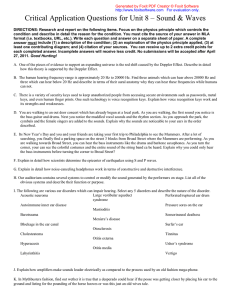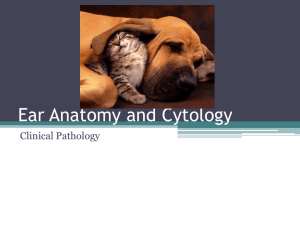Document 14233442
advertisement
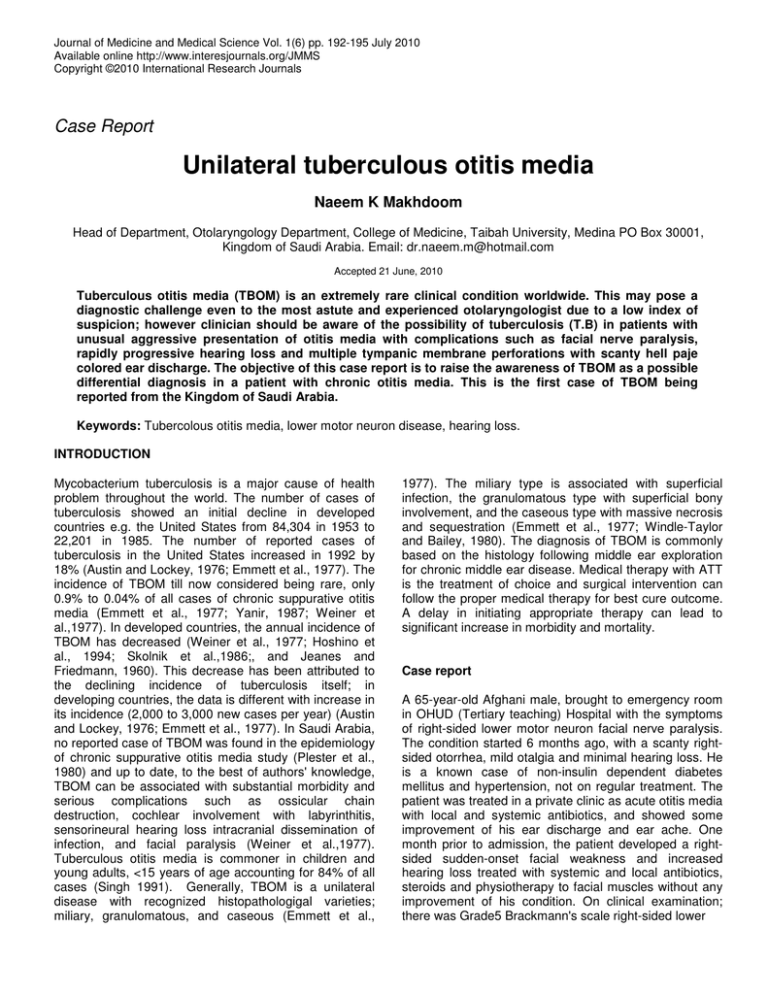
Journal of Medicine and Medical Science Vol. 1(6) pp. 192-195 July 2010 Available online http://www.interesjournals.org/JMMS Copyright ©2010 International Research Journals Case Report Unilateral tuberculous otitis media Naeem K Makhdoom Head of Department, Otolaryngology Department, College of Medicine, Taibah University, Medina PO Box 30001, Kingdom of Saudi Arabia. Email: dr.naeem.m@hotmail.com Accepted 21 June, 2010 Tuberculous otitis media (TBOM) is an extremely rare clinical condition worldwide. This may pose a diagnostic challenge even to the most astute and experienced otolaryngologist due to a low index of suspicion; however clinician should be aware of the possibility of tuberculosis (T.B) in patients with unusual aggressive presentation of otitis media with complications such as facial nerve paralysis, rapidly progressive hearing loss and multiple tympanic membrane perforations with scanty hell paje colored ear discharge. The objective of this case report is to raise the awareness of TBOM as a possible differential diagnosis in a patient with chronic otitis media. This is the first case of TBOM being reported from the Kingdom of Saudi Arabia. Keywords: Tubercolous otitis media, lower motor neuron disease, hearing loss. INTRODUCTION Mycobacterium tuberculosis is a major cause of health problem throughout the world. The number of cases of tuberculosis showed an initial decline in developed countries e.g. the United States from 84,304 in 1953 to 22,201 in 1985. The number of reported cases of tuberculosis in the United States increased in 1992 by 18% (Austin and Lockey, 1976; Emmett et al., 1977). The incidence of TBOM till now considered being rare, only 0.9% to 0.04% of all cases of chronic suppurative otitis media (Emmett et al., 1977; Yanir, 1987; Weiner et al.,1977). In developed countries, the annual incidence of TBOM has decreased (Weiner et al., 1977; Hoshino et al., 1994; Skolnik et al.,1986;, and Jeanes and Friedmann, 1960). This decrease has been attributed to the declining incidence of tuberculosis itself; in developing countries, the data is different with increase in its incidence (2,000 to 3,000 new cases per year) (Austin and Lockey, 1976; Emmett et al., 1977). In Saudi Arabia, no reported case of TBOM was found in the epidemiology of chronic suppurative otitis media study (Plester et al., 1980) and up to date, to the best of authors' knowledge, TBOM can be associated with substantial morbidity and serious complications such as ossicular chain destruction, cochlear involvement with labyrinthitis, sensorineural hearing loss intracranial dissemination of infection, and facial paralysis (Weiner et al.,1977). Tuberculous otitis media is commoner in children and young adults, <15 years of age accounting for 84% of all cases (Singh 1991). Generally, TBOM is a unilateral disease with recognized histopathologigal varieties; miliary, granulomatous, and caseous (Emmett et al., 1977). The miliary type is associated with superficial infection, the granulomatous type with superficial bony involvement, and the caseous type with massive necrosis and sequestration (Emmett et al., 1977; Windle-Taylor and Bailey, 1980). The diagnosis of TBOM is commonly based on the histology following middle ear exploration for chronic middle ear disease. Medical therapy with ATT is the treatment of choice and surgical intervention can follow the proper medical therapy for best cure outcome. A delay in initiating appropriate therapy can lead to significant increase in morbidity and mortality. Case report A 65-year-old Afghani male, brought to emergency room in OHUD (Tertiary teaching) Hospital with the symptoms of right-sided lower motor neuron facial nerve paralysis. The condition started 6 months ago, with a scanty rightsided otorrhea, mild otalgia and minimal hearing loss. He is a known case of non-insulin dependent diabetes mellitus and hypertension, not on regular treatment. The patient was treated in a private clinic as acute otitis media with local and systemic antibiotics, and showed some improvement of his ear discharge and ear ache. One month prior to admission, the patient developed a rightsided sudden-onset facial weakness and increased hearing loss treated with systemic and local antibiotics, steroids and physiotherapy to facial muscles without any improvement of his condition. On clinical examination; there was Grade5 Brackmann's scale right-sided lower Naeem 193 Figure 1.CT scan of the mastoid region demonstrating advanced bony sclerosis due to longstanding chronic inflammation. Figure 2.Shows a granuloma which is made up numerous lymphocytes, histiocytes, epitheloid cells and many langhan giant cells. motor neuron lesion of the facial nerve. Otoscopic examination showed thick Hell page colored right-sided otorrhea and subtotal tympanic membrane perforation. Investigations were as follows: ear swab for culture and sensitivity (C&S) showed no bacterial growth, routine blood investigations CBC, Urea and electrolyte results was insignificant, random blood sugar was mildly elevated, Schuler view mastoid x-ray showed sclerotic mastoid changes. High-resolution computed tomography (CT) showed extensive soft tissue densities in the tympanic cavity, antrum and the mastoid along with reactive bone sclerosis (figure 1). Chest x-ray was unremarkable, pure tone audiogram revealed a right-sided profound mixed hearing loss (figure 2). Patient was admitted to the hospital and a radical mastoidectomy was performed. Intraoperatively another ear swab collected for acid fast bacilli (AFB), culture and sensitivity and Zell Nelson staining. The granulation tissue was removed from the middle earand mastoid cavity. Exposed vertical facial nerve bony canal was identified and a biopsy was obtained for histopathological study. Postoperatively, the patient had an uneventful recovery from surgery except for irritating and productive cough with yellowish sputum, which was subjected for AFB staining. Culture and sensitivity report returned as negative and his Mantoux’s test was reported to be positive. After pulmonology consultation the patient was started on anti-tuberculous therapy (ATT). Later on a middle ear biopsy revealed a chronic granulomatous inflammatory change consistent with tuberculosis (figure 3). After two weeks, the patient was discharged home and monitored closely on regular follow-up visits in ENT 194 J. Med. Med. Sci. Figure 3. High power showing multinucleated langhan giant cell, the slipper shaped epitheloid cell morphology is very clear indicating that this is granulomatous lesion. and chest clinics. The patient completed his antituberculous treatment, had a dry ear but there was no improvement of hearing loss or facial palsy status. DISCUSSION TBOM can develop secondary to blood-borne infection, disseminating through eustachian tube or externally through external auditory canal (Windle-Taylor and Bailey,1980). Various clinical manifestations of TBOM have been described; aural discharge (commonest), hearing loss (Windle-Taylor and Bailey, 1980) of either conductive (90% of patients), sensorineural (~8%), or mixed (~2%) (Wallner 1953) and otalgia (Weiner et al., 1977; Windle-Taylor and Bailey,1980;, Hoshino et al.,1994, Wallner 1953). Facial nerve paralysis is seen in 35% of pediatric cases and in16% of adults with TBOM (Singh 1991; Wallner 1953; and Palva et al., 1973). Another reported presentation in literature is extradural abscess formation and tuberculous meningitis (Skolnik et al., 1986). Labyrinthitis and petrositis have also been reported in association with the mastoid disease (Emmett et al., 1977; Windle-Taylor and Bailey, 1980; and Skolnik et al., 1986). Examination of the affected ear will usually reveal pale-yellow granulation tissue on a thickened and hyperemic tympanic membrane. Perforations usually occur early in the disease as a result of the coalescence of the granulomas in the area of the granulation (WindleTaylor and Bailey, 1980; Hoshino et al., 1994). The consistency of the discharge ranges from thick and mucoid to thin and watery. The granulomatous process leads to destruction of the ossicles, which can be viewed through the perforated tympanic membrane (Emmett et al., 1977; Yanir 1987; Weiner et al., 1977; Windle-Taylor and Bailey,1980;and Skolnik et al.,1986). With disease progression, the profused amount of granulation tissue leads to an attic-antral blockage and a direct extension of the mucosal disease is complicated into mastoiditis or tuberculous osteomyelitis of the temporal bone. The differential diagnosis is broad and includes bacterial otitis media, cholesteatoma, necrotizing otitis externa, lymphoma, histoplasmosis, blastomycosis, syphilis, midline granuloma, Wegener's granulomatosis, histiocytosis-X and nocardiasis (Hoshino et al., 1994; Palva et al., 1925). The diagnosis of TBOM may be difficult and represents a real problem, even with a thorough tuberculous follow up. A few numbers of patients can be detected (26%), in case where there is no other manifestation of tuberculosis. The prevalence of active or inactive pulmonary tuberculosis in patients with TBOM ranges from 14 to 93% (Weiner et al.,1977; Skolnik et al., 1986; Plester et al.,198; Ramages and Gertler,1985; Ramages and Gertler, 1955;Odetoyinvo 1988), which is usually overlooked in the early stages of the disease and is established postoperatively for otitis media (Weiner et al.,1977; M'Cart 1925; Munzel 1978; Awan and Salahuddin,2002; Mumtaz et al.,1983) as what happened in this case. Patients with known or suspicion of active extra-aural tuberculosis with chronic supportive otitis media must be subjected for TBOM work up (Windle-Taylor and Bailey, 1980; Skolnik etal.,1986;, and Wallner 1953). The microbial studies, culture and staining of ear discharge have showed that 40 - 50% of patients suffering with TBOM revealed no evidence of tuberculosis elsewhere (Skolnik et al.,1986;, Jeanes and Friedmann,1960; Plester et al.,1980; Singh 1991). In 5 35% of TBOM cases, external ear canal cultures are positive for tuberculosis, and smears are positive in approximately 20% (Ramages and Gertler, 1985). Seventy nine percent of TBOM showed secondary bacterial infection which can prevent the identification of Mycobacterium tuberculosis on either staining or culture (Plester et al., 1980; Singh 1991; M'Cart 1925; Mathens Naeem 195 1907; and Munzel et al., 1978). Plain x-rays of mastoid are usually of little help because the increased density of the soft tissues does not reveal much information. A computed tomography (CT) is useful in the diagnosis of tuberculous otitis media as mastoiditis changes can be seen in a better way and it is superior to magnetic resonance imaging and finally chest x-ray might also help in the diagnostic process (Weiner et al., 1977; WindleTaylor and Bailey, 1990; Skolnik et al.,1986). Conclusion Fortunately, tuberculous otitis media is a rare disease worldwide including Saudi Arabia. The treating clinician must have a high index of suspicion of TBOM as a differential diagnosis possibility in chronic suppurative otitis media cases, as early diagnosis, treatment with ATT and surgical intervention can prevent serious complications. REFERENCES Austin WK, Lockey MW (1976). Mycobacterium fortuitum. Arch. Otolaryngol. 102:558-580 Awan MS, Salahuddin I (2002). Tuberculous otitis media: two case reports and literature review. Ear Nose Throat J. 14(3):114-117. Emmett JR, Fischer ND, Biggers WP (1977). Tuberculous mastoiditis. Laryngoscope 87:1157-1163 Hoshino T, Miyashita H, Asai Y (1994). Computed tomography of the temporal bone in tuberculous otitis media. J. Laryngol. Otol. 108:702705. Jeanes AL, Friedmann I (1960). Tuberculosis of the middle ear. Tubercle 41:109-116 Mathens P (1907). Tuberculosis of middle ear in children. Ann. Otol. Rhinol. Laryngol.16:390-425. M'Cart HW (925). Tuberculous disease of the middle ear. J. Laryngol. Otol. 40:456-466. Mumtaz MA ,Scwartz RH, Grundfast km, Baumyartner RC (1983). Tuberculosis of the middle ear and mastoid. Pediatr. Infect. Dis. 2:234-236 Munzel MA (1985). Tympanoplasty and tuberculosis of the middle ear. Clin. Orolaryngol. 3:311-313. Odetoyinvo O (1988). Early diagnosis of tuberculous otitis media. J. Laryngol. Otol. 102:133-135. Palva T, Palva A, Karja J (1973). Tuberculous otitis media. J. Laryngol. Otol. 87:253-261. Plester D, Pusalkar A, Steinbach E (1980). Middle ear tuberculosis. J. Laryngol. Otol. 94:1415-21. Ramages LJ, Gertler R (1985). Aural tuberculosis: A series of 25 patients. J. Laryngol. Otol. 99:1073-1080. Singh B (1991). Role of surgery in tuberculous mastoiditis. J. Laryngol. Otol. 105:907-915. Skolnik PR, Nadol JB Jr., Baker AS (1986). Tuberculosis of the middle ear: Review of the literature with an instructive case report. Rev. Infect. Dis. 8:403-410. Wallner LJ (1953). Tuberculous otitis media. Laryngoscope. 63:10581077. Weiner GM, O'Connell JE, Pahor AL (1977). The role of surgery in tuberculous mastoiditis: Appropriate chemotherapy is not always enough. J. Laryngol. Otol. 111:752-753. Windle-Taylor PC, Bailey CM (1980). Tuberculous otitis media: A series of 22 patients. Laryngoscope. 90:1039-1044. Yanir E (1987). Tuberculous otitis media; clinical record, Laryngoscope 97:1303-6
